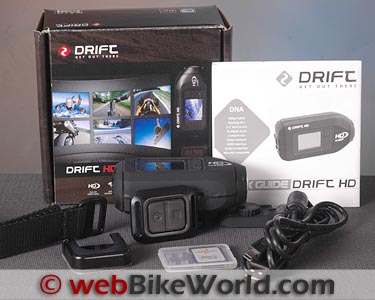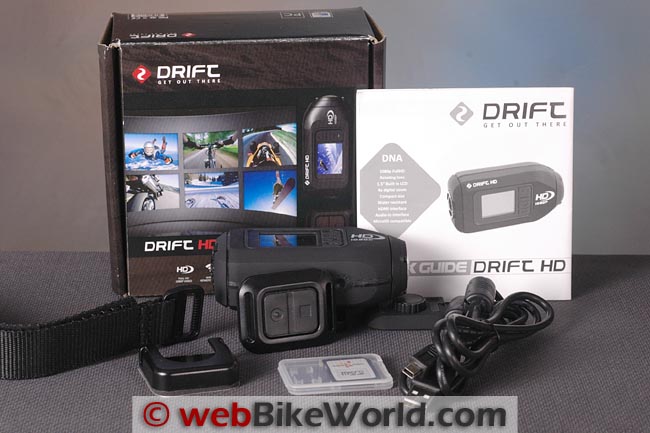The new Drift HD includes all of the features of the Drift HD170 (review) — a webBikeWorld favorite — in a smaller form factor.
The Drift HD has a few added features of its own, including an updated button layout that makes it even easier to use.
The live view and simple menu system is still there and the Drift HD can record in H.264 1080p at 30 fps or 720p video in 30 and now 60 fps also.
And for that quaint 2008 effect, it can even record in SD!
The new Drift HD “Point of View” video camera is, for all practical purposes, a slightly updated, 3/4-sized version of the Drift HD170 — one of our favorite motorcycle video cameras.
Smaller is definitely better when it comes to motorcycle video cameras and the Drift HD170 is a bit bulky compared to cameras like the Contour HD (review) or the Contour HD GPS (review).
Actually, the Drift HD is about the size that the HD170 should have been — and even smaller would be nicer.
Just by coincidence, we have a new Replay XD1080 video camera which will be reviewed next.
It’s smaller still, although it doesn’t have the live view. A Contour Plus review is also on the way also, so stay tuned.
Other than its shrunk-in-the-wash size difference and a few other small details, the Drift HD is nearly identical to its bigger brother.
That includes the very easy-to-use menu system and the live view, along with a 170-degree field of view, a lens that can be rotated 300 degrees and a built-in metal tripod mount.
The Drift HD uses a microSD card rather than the SD card of the Drift HD170, and this is both a plus and minus.
The plus is that the use of a microSD card goes a long way towards reducing bulk.
But if you’re not careful, a microSD card can pop right out of its spring-loaded slot in the camera and fly off into Never-Never Land. Believe me, it’s happened.
The Drift HD records in 1080p or 720p and one new added difference is that the Drift HD can also record in 720p at 60 fps (frames per second) for a slightly slow-mo effect.
Otherwise, the cameras have nearly identical video quality, although the Drift HD170 does seem to have just a slight edge in quality, color rendition and speed in automatic exposure control.
The list price of the Drift HD is $369.00, $20.00 more than the Drift HD170 and it will go on sale on October 15, 2011.
Is it worth 20 bucks more? We think so, but only if you’re buying a Drift HD camera for the first time.
There’s no reason for Drift HD170 owners to upgrade at this point and the Drift HD170 is a fine video camera. It’s still in production also, so no worries there.
Drift HD Specifications
The Drift video camera form factor and the Drift operating system is pretty solid, which means there aren’t many differences at all between the non-HD Drift X170 video camera (review), theDrift HD170 (review) and the Drift HD.
If you know how to use one, you know how to use ’em all.
And you’ll barely need to read the instructions, because everything is right there in the color menu screens on the live view.
Having a live view is a huge advantage in a motorcycle video camera because you can line up the shot as you mount the camera — and you can even watch your video to make sure what you see is what you get.
Tip: Pull over to the side of the road before you watch it though!
In the Box
The Drift HD uses the same 3.7 Volt lithium-ion 1110 mAh battery (4 x 21 x 13 mm) as the Drift HD170. It takes the same 1080p or 720p (or standard definition) video s, while the X170 video is a wide format only at 720×480 pixels.
All of the Drift cameras use a soft-touch, semi-ruggedized and water-resistant body.
The Drift HD measures 133 mm long by 50 mm thick by 33 mm wide and weighs 142 grams with the battery (30 grams lighter than the Drift HD170).
The Drift HD comes with a 4GB microSD card and an SD adapter. It also comes with a goggle mount, a USB cable and the very handy Drift remote control.
The remote control can be strapped to a heavy-duty webbed wrist belt, also included. The remote can be used to start and stop the video without having to fumble for the buttons on the camera.
Drift sent us a pre-production Drift HD when the camera was in the development stage and we provided feedback during the summer.
The changes we suggested have been incorporated into the final production versions. Drift video cameras can be firmware updated also for free via the Drift website.
So let’s take a closer look at the Drift HD and we’ll compare it to the new Replay XD1080 (review)and Contour Plus in our upcoming reviews.
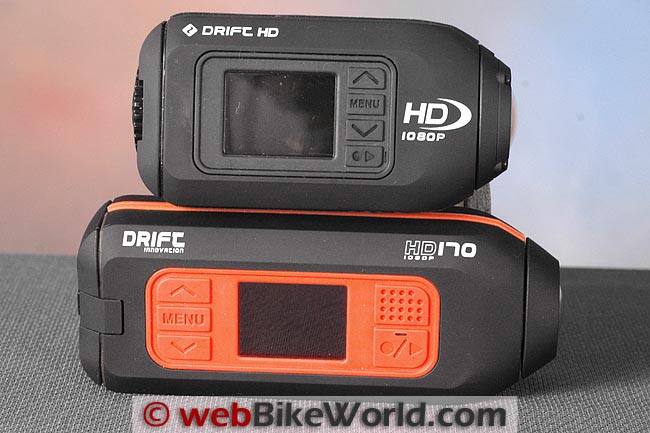
Ease of Use
Much of what I wrote about the Drift HD170 can be repeated here, because the Drift HD uses the same intuitive menu system, with just a few more options.
In fact, the button placement on the Drift HD is even better, because the buttons are in a single row on the right-hand side of the live view screen.
This makes the Drift HD even easier to use because you don’t have to move back and forth across the LCD to find the “Enter” button and there’s no need to “two-hand” the camera/
The membrane buttons are rubber covered and the entire camera is water resistant, with an O-ring sealing the rear cover. Push the On/Off button once to fire up the camera, then push it again to start recording.
Remember that it’s best to record a series of short videos. 1080p takes a lot of disk space and you can easily end up with multi-gigabyte file sizes that are very difficult to copy, edit and share.
Once the camera has been turned on, the remote control can be used to start and stop the video. The remove slides over the included wrist strap, which can be worn over the arm of a jacket, like a wristwatch.
The Drift HD comes with a small set of instructions, but the camera is so easy to use, the instructions are hardly necessary — a good thing when you’re out on the road, on skis or wherever.
In contrast, I almost always have to carry the instructions for the GoPro HD (review) although the new live view “Backpack” helps.
One trick to remember with the Drift live view is to always look at it in landscape mode, from left to right with the lens on the right.
Then rotate the lens so the view is oriented correctly in the landscape mode and your video will be recorded correctly.
Also, one of the uses of a live view is to place the camera on the helmet or other location, record a few seconds of video, then check the live view to make sure the video is in the correct orientation and the lens is also oriented so that it captures the desired view.
This is important because of the wide field of view on the Drift HD, which changes your notion of how to line up the camera for the best shot and it does take some practice to get it right.
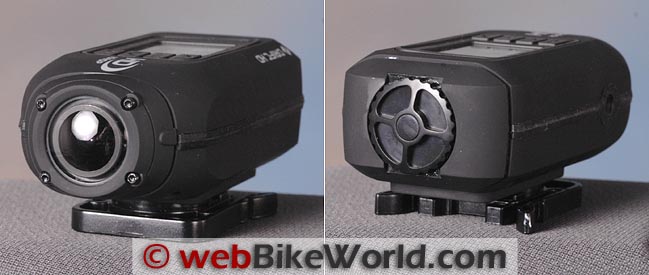
Mounting the Drift HD
Mounting a motorcycle video camera is always an issue, which is one of the reasons why smaller is better. The Drift HD is slightly easier to mount on a helmet or on the bike than the 25% larger Drift HD170.
The camera has a built-in metal tripod mount using the standard 1/4-20 threads. This is another plus — not all motorcycle video cameras include this feature that we think should be mandatory.
The Drift HD works very nicely when mounted on the Delkin “Fat Gecko” suction cup mount (review).
The camera also comes with a clip and adapter for a goggle mount, which I tried with the new Vemar VRX7 composite motocross helmet (review), but the Drift HD feels a bit too heavy for the elastic strap on the Scott 87 OTG goggles (review).
So the best method for mounting the Drift HD is either on the Delkin suction cup mount or by using the goggle mount and some no-residue duct tape or gaffer’s tape to hold it on to the top of the helmet.
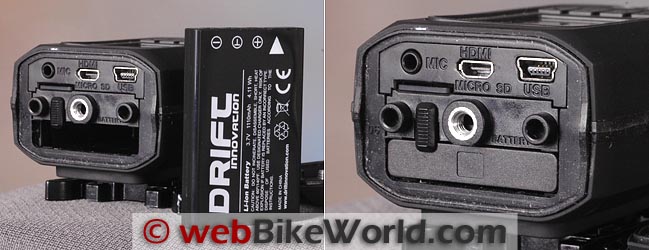
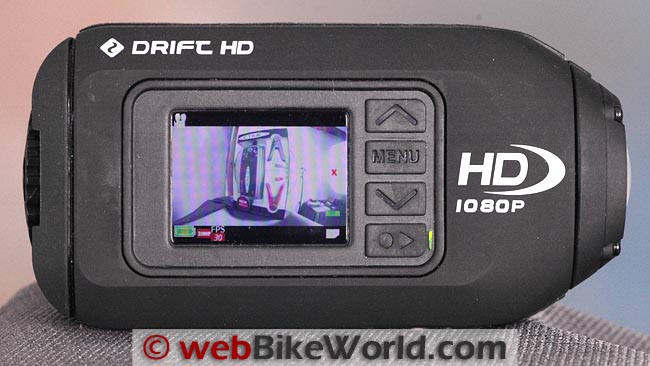
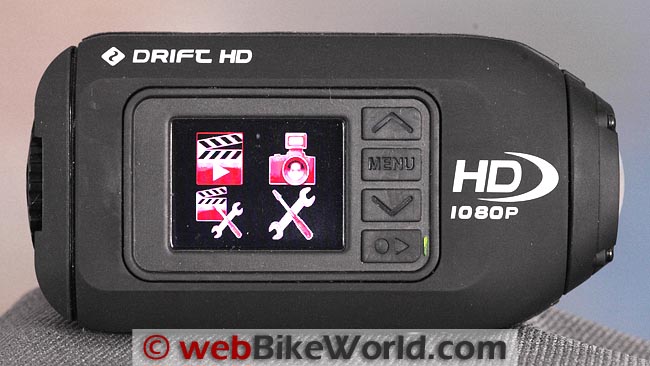
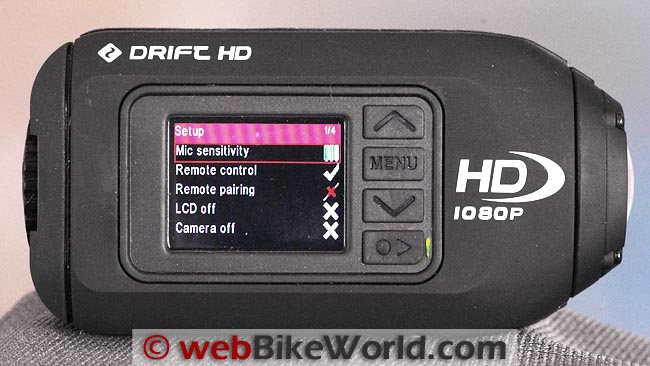
Video Types and Quality
The Drift HD takes excellent quality video for a dedicated motorcycle video camera. It is comparable to the Drift HD170, the GoPro HD (review) and the Contour HD (review).
We’re working on a video comparing the Drift HD, the GoPro HD, the Drift HD170 and the Replay XD1080 and that video will be available in an upcoming review of the Replay XD1080, along with some narrative comparing the Replay XD1080 to the Drift HD.
The Drift HD and HD170 have a very wide angle lens, capturing a 170-degree field of view.
Care must be taken to mount the cameras as close to true horizontal as possible, or there will be some barrel distortion noticeable.
The camera takes video in either 1080p at 30 fps or 720p at 30 fps or 60 fps. It will also take individual photos or time-lapse photos in intervals of 2, 3, 5, 10 or 30 seconds.
Tip: the faster you go, the faster you want to take the interval photos.
The photos can be strung together in an application such as Microsoft Movie Maker or Adobe Premiere Elements to create a video (Version 10 of Premiere Elements was just released and it works very nicely).
The video below is a good example of the video quality from the Drift HD.
Note that it has been processed from the raw .MOV H.265 state and saved as 1080p .mpeg in Photoshop Premiere Elements 10, then imported to YouTube where it is compressed again.
So the quality you see is slightly degraded from the actual quality of the video as played on your computer.
Like most of these simple motorcycle video cameras, the Drift HD has a noticeable auto-exposure lag time when moving from light to shadows (or vice-versa) as the motorcycle is moving.
Watch closely and you can see the automatic exposure stepping up or down as it compensates for the ambient lighting.
Like the Drift HD170, the Drift HD tends to have a cool color cast in the shadows and a slightly oversaturated, warm color cast in the sunlight. We think the GoPro HD has the best color and exposure rendition so far of any motorcycle video camera, but the gap is narrowing.
Also, it tends to underexpose in the shadows by about 1/2 stop and overexpose in bright light by perhaps 1 stop.
The Drift HD does have a unique feature available in the menu system that allows modifying the automatic exposure by one or two stops plus or minus. It also has a night mode for taking video in lower ambient lighting conditions.
Also, the Drift HD seem to have eliminated the “rolling shutter effect” and the video looks crisp and clear with minimal artifacting, at least when played locally on the computer.
Drift HD Feature Demonstration and Video Sample
Here’s a video that first quickly runs through the features of the new Drift HD. After that, a Drift HD video sample clip that was taken from the four-camera comparison is shown, then a video taken with the Drift HD mounted on top of a helmet during a ride.
The weather has been on and off rain and clouds over the last several weeks, so the roads were mostly wet and it was somewhat difficult to find consistent lighting conditions.
NOTE: The quality of the video as displayed on YouTube is lower than the quality of the original .MOV file as viewed on your computer.
The YouTube video below was first processed from the raw .MOV H.264 state and saved as a 1080p .mpeg in Photoshop Premiere Elements 10, then imported to YouTube, where it is compressed again.
Each time the video is processed, the quality usually degrades slightly. The original file is devoid of the artifacts visible in the YouTube video as the camera moves into the shadows. Here’s a 10-second raw .MOV file sample from the camera (.zip file).
NOTE: For best results, select the highest quality playback under the gear icon in YouTube
Other Features of the Drift HD
The Drift HD has an external mic located along the bottom and a remote microphone port, located in the rear under the battery compartment cover.
The standard battery compartment cover screws on tightly and the camera has an O-ring to keep out moisture.
Like the Drift HD170, the Drift HD seems more water-resistant than most other motorcycle video cameras.
The Drift HD also includes a built-in speaker and microphone. We didn’t have a remote mic handy so we did not try the remote mic input port.
The camera comes with a second rear cover that has openings for a remote mic cable and a USB cable to power the camera or to recharge it.
Drift has several options available, including a longer life battery pack, and external battery pack, a waterproof case, a long-life spare battery and more. The battery life of the battery that is provided with the Drift HD is a bit weak, lasting only about 45 minutes when taking 1080p video.
Pressing the various buttons on the Drift HD creates a “beep” tone, but it’s difficult to hear it over the noise of a motorcycle and while wearing a helmet and ear plugs.
Also, the buttons are difficult to locate when you’re wearing gloves if the camera is out of sight, like when it’s mounted on top of the helmet.
So the remote control comes in very handy, although you’ll have to keep your fingers crossed that the recording has started or stopped as expected.
The Drift HD will accept microSD cards up to 32GB in size. It comes with a 4GB microSD card and adapter. Drift requires only a minimum of a Class 4 card, which helps lower the cost if you want to upgrade to a larger capacity card.
The camera kit does not include a case, an important accessory for any camera and especially for a motorcycle video camera with an exposed lens.
A case that allows the camera to be stored and carried and that can also hold some of the accessories should most definitely be included, especially considering the list price of the Drift HD!
One thing you should always have with you when outdoors with a video camera is a high-quality microfiber lens cleaning cloth to clear the bugs and grime off the lens, but do it carefully.
The lens on the Drift HD is exposed and its curvature makes it fairly easy to damage.
|
webBikeWorld Overall Opinionator: Drift HD Video Camera
|
|
|---|---|
| Picks… | …and Pans |
|
|
Conclusion
The Drift HD is another very nice camera from Drift Innovation.
It takes excellent quality video and it’s very easy to use, which is a big plus because a motorcycle video camera isn’t something that’s used every day, so it pays to have one that doesn’t require studying the owner’s manual every time you want to use it.
The live view, the remote control and the menu system are the main benefits of the Drift video camera system and it’s worth paying extra to get these features.
$369.00 does seem like a lot of money though when the Drift HD is compared to the cost of a good quality personal use digital camera.
Most cameras today have outstanding HD quality video that is still generally better than the video quality found in the dedicated motorcycle video cameras like those made by Drift, GoPro or anyone else.
However, you’re paying for the different construction and shape.
And certainly there’s an economy of scale factor, because nowhere near as many motorcycle video cameras are sold compared to digital cameras from Nikon, Panasonic, Sony, etc.
Stay tuned and we’ll see how the Drift HD compares to the new Replay XD1080 (review)!
More webBikeWorld:
▪ Video Action Camera Reviews
▪ Intercom and Radio Reviews
|
wBW Review: Drift HD Video Camera
|
|
|---|---|
| Manufacturer: Drift Innovation | List Price: $369.00 USD. |
| Colors: Black. | Made In: China |
| Review Date: September 2011 | |
Owner Comments and Feedback
See details on submitting comments.
From “E.L.” (September 2011): “Regarding your mention of the 45 minute battery life in the review of the new Drift HD: was that recording with the live view on? If it’s possible to record with the LCD off, you should get noticeably more record time per charge. Thanks again for all your good work!”
Editor’s Reply: Yes, it was with the live view on. Drift says 3 hours with the LCD screen off and 2 hours with the LCD screen on. Battery life is same for both the Drift HD170 and the Drift HD.


